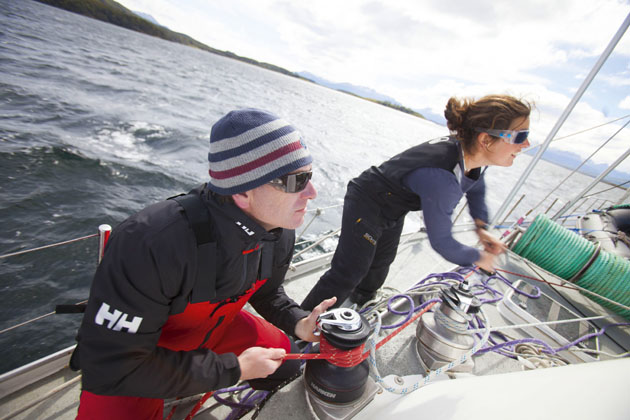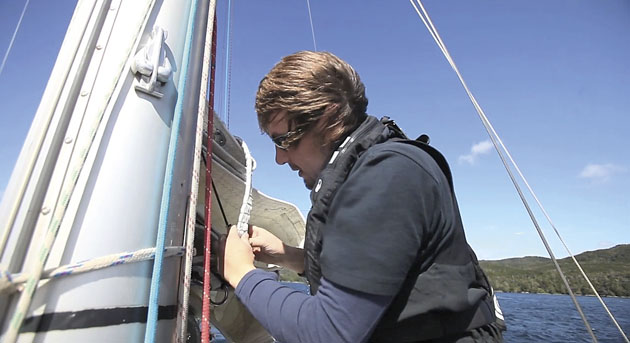The ability to reduce sail area quickly is fundamental for storm sailing. Skip demonstrates what he regards as the only foolproof reefing method for a true offshore cruiser
Sail handling exclusively from the cockpit without having to go forward is highly desirable on any cruising boat, especially when storm sailing. Reliable headsail furling systems have certainly achieved that goal, but reefing the mainsail still presents a dilemma.
In-mast and in-boom furling systems deserve a mention here. In-mast mainsail furlers have persisted in spite of an increased mast weight package and a mechanism buried inside the mast profile. When it works, great, although it means a mainsail undercut on the leech owing to a lack of battens and therefore a less than optimal sail shape.
When it doesn’t work – in the worse case a jam-up with a flogging sail that won’t roll up – it can become an unforgettable experience. It must be said, though, that the system is a nice idea for inshore sailing in benign conditions.
In-boom furlers appear to be purely a style item, especially in the superyacht range. A flaked mainsail on the boom, even under a neatly cut cover, is now considered untidy by some designers and owners. But these systems suffer the same problems, compounded by the necessity for an exacting control system that lowers the sail and rolls it up at the same rate, with the boom at a hyper-critical angle.
It may work a treat at the dock, but as any superyacht captain worth his salt will admit it is a nerve-racking experience offshore. Result: fear and loathing about using the mainsail at all. The adage now goes that it is cheaper to pay for fuel and motor than risk damage to the sail or the mechanism. Again, not my recommendation for a world cruising configuration.
Slab reefing
Slab reefing is the only seamanlike system, full stop, as there is not much that can go dramatically wrong. As with so many aspects of voyaging offshore, we are back to basics here: a slab reefing system with a fixed tack and clew lines. The prime advantages are that all moving parts are exposed and easily repairable – for example, mast track, cars and sliders, blocks and rigging – you have the ability to cast off the halyard and drop the mainsail in a crisis, and a better-shaped sail is achievable as you drop down through the reefs.
A side debate exists between a single-line system and a tack line with hook or shackle. There is no doubt that to be able to reef the sail without leaving the cockpit is a good thing, especially if the crew is not agile for any reason. This can only be achieved in the slab system by a single-line arrangement.
However, there are several downsides. Single-line systems, where a continuous line is threaded through both the tack and the clew to bring each reef home, requires an enormous amount of line. If you have three reefs as a minimum and four as recommended the cockpit will become a bowl of multicoloured spaghetti and pretty unmanageable.
Secondly, the friction in the system is also an issue as the line runs through so many turning points, plus there is more chance for line and sail chafe along the way. Lastly, it is difficult to set the tack and the clew in the right position and impossible to make any adjustment to either independently.
Going forward is necessary
Slab reefing can be managed from the cockpit by having the halyard, a tack line and clew lines led aft. However, to make the tack fast and create a solid connection of the tack to the gooseneck without chafe, going forward at some point in the exercise is necessary. This is not a bad idea in itself as it forces you out of the cockpit to have a look at all things forward!
A tack line to help the luff of the sail come down might be necessary depending on the friction of the track and car system. In any case, a shackle on a strop is clipped into to each successive tack ring; the deeper the reef, the longer the strop must be to allow for the stacked sail. If using a tack line it must then be clipped into the next reef tack ring aloft, which might require a few steps to safely go up the mast. Acrobatics? Yes, but then you know you are properly set for the long haul.
Drawbacks? Other than the need to get off your butt and go forward, the only one I see is the issue of the stowage of the bunt of the mainsail on the boom, especially for long runs under reefed sail, as this can lead to chafe issues. Having some sort of platform on top of the boom (a poor man’s Park Avenue or hayrack) helps as it supports the bunt, but it is also necessary to prevent the bunt from creeping over the edge if there is slack in the sail, creating a bag that can fill with water.
Lashing the sail through reef points can work, but it can also cause chafe with the whole bundle working, and laminated sail fabric doesn’t like to be creased.
One system that keeps the bunt under tension aft and helps solve the problem is a cringle halfway between successive reefs, where the fall of the reef line passes through before it is made fast to the boom.
Spreader angle
Radically swept-back spreaders are now a feature of most modern rigs, but I would not advocate this configuration for a world cruiser. You will quickly find out why when having to reef downwind (when it is not advisable to head up and put the wind forward because of strong winds and big sea conditions). The mainsail will be plastered against a very sticky, irregular surface and will be a mission to lower away, not to mention leading to continuous chafe issues when underway downwind. I believe a cutter rig is essential for world cruising and this means having running backstays so that you won’t require radically swept-back spreaders.
Taking a slab reef
If it becomes a drama you have left it too late. Cruising should be a conservative affair. There is little difference in boat speed with, say, a single reef at the top end of its range and the second reef near the bottom of its range. So think ahead. If the wind is on the rise, reef deeply, go slow for a while and take time to check all else on board.
Even if you have done it before, talk through the manoeuvre with your crew in a step-by-step cookbook approach.
The beauty of this procedure, especially with a fully battened mainsail, is that the sail will feather when the sheet is eased and will not flog, so you can take you time. Also when taking more than one reef in one go, take the reefs in one by one so there is no slack in the lazy clew lines.
Step by step
Here is the step-by-step procedure, which is also shown in our video:
- Make sure your main halyard is flaked out, won’t foul and can’t get washed overboard.
- Ease the mainsail to take all load off the sail.
- Take in the slack of the boom preventer in any kind of seaway where the boom might flog – this is necessary when short-handed. If enough crew is available, one should man the sheet during the entire manoeuvre, playing the sail, taking in slack and easing when needed and being aware of clew and halyard tension.
- Pre-tension the active clew line to give some leech tension.
- Lower the halyard only as fast as you bring in the tack line (if used) and the clew line so the sail comes down in control like a window blind. Avoid letting the leech flog. If sailing solo or short-handed this might have to be done in alternate stages.
- As you bring down the sail, take in the slack on the other clew lines to avoid them fouling on the boom end.
- When the reef tack is down, attach the shackle or put the ring on the bullhorn.
- Rehoist the halyard for proper tension.
- Take in the remaining clew line, easing the mainsheet to so the boom rises up to the new clew. Check that the loose sail cloth is not drawn into the clew block or that there is line chafe on the sail.
- Trim the main sheet back on.
- Reattach the tack line to the next reef ring aloft.
- Adjust leech line if need be.
- Secure all clew lines and the halyard tail.
Taking a reef out is pretty much the reverse procedure. By the time the wind has dropped making more sail should be a very relaxed manoeuvre. In all things, be meticulous!
Part 6: preparing the deck
Making sure everything is absolutely secure in heavy weather needs exhaustive preparation including stowing the dinghy below deck and double-checking safety equipment
12-part series in association with Pantaenius







